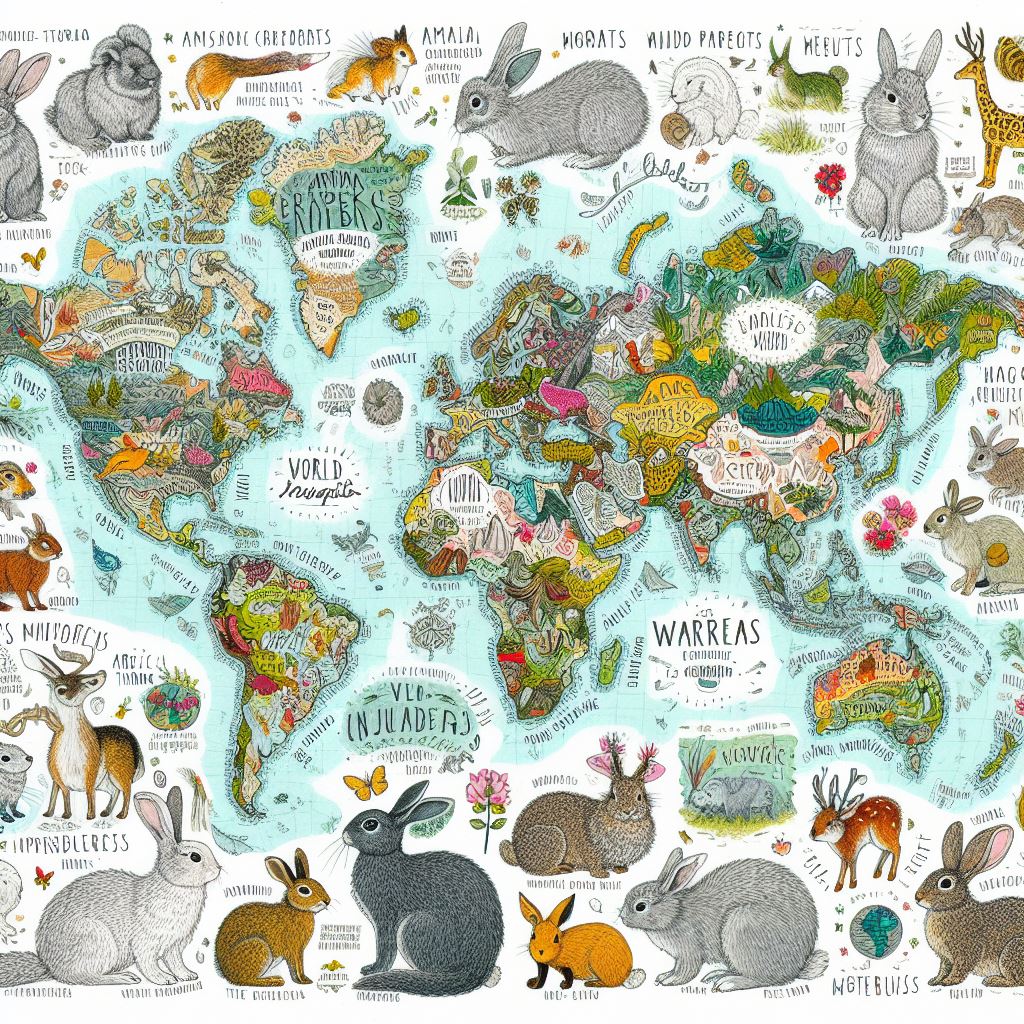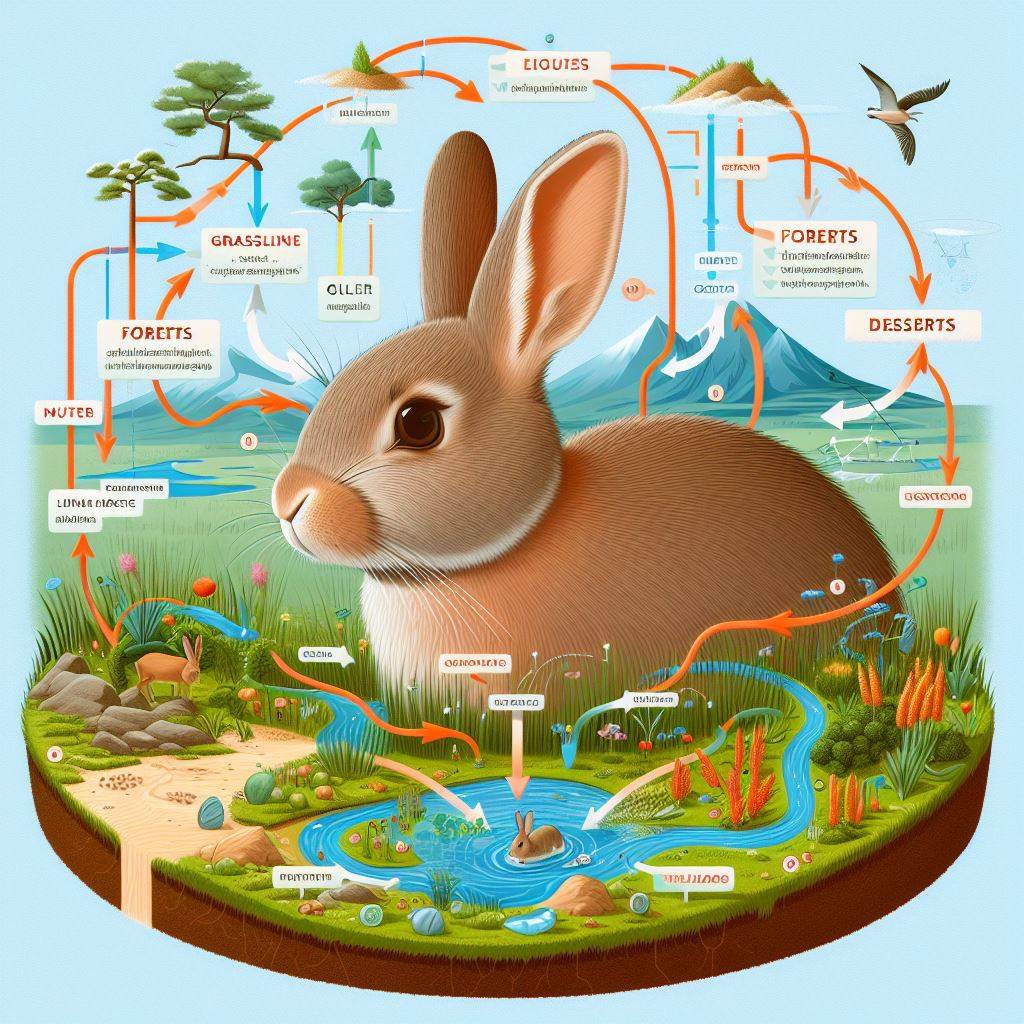Explore the fascinating world of rabbit habitats with our comprehensive guide on where rabbits live map. Gain insights into their diverse environments, burrow architecture, and the challenges they face. Discover the importance of mapping rabbit habitats for conservation efforts.
Introduction
Welcome to the enchanting world of rabbits, where their habitats unfold like a captivating map, revealing the diverse landscapes they call home. Our guide, Miss Weronika, invites you on a journey to explore “Where Rabbits Live Map?” As an esteemed author passionate about wildlife, she unravels the mysteries of rabbit habitats with a perfect blend of expertise and fascination.
In this exploration, we’ll delve into the geographic wonders, burrowed secrets, and adaptive wonders of rabbits. Her keen insights will paint a vivid picture of the intricate environments where these charming creatures thrive. Join us as we navigate through the pages of this rabbit habitat map, understanding the importance of their homes and the challenges they face in the ever-changing landscapes.
Through the author’s lens, we aim to make the complex world of rabbit habitats accessible and intriguing, fostering a deeper appreciation for these furry inhabitants and the ecosystems they contribute to. So, let’s embark on this delightful journey and discover “Where Rabbits Live Map?” with our knowledgeable guide at the helm.

Where Rabbits Live Map?Discovering Bunny Residences
Welcome to the “Where Rabbits Live Map – Discovering Bunny Residences”! This interactive map is designed to help you explore the various habitats where rabbits make their homes. Rabbits are adaptable creatures that can be found in a variety of environments, from grassy meadows and woodlands to urban gardens and even desserts. By using this map, you can gain insights into the diverse locations where these furry friends build their nests and burrows.
The map provides valuable information on the specific features of each rabbit habitat. You’ll learn about the types of vegetation they prefer, the hiding spots they choose for safety, and how they utilize their surroundings for food and shelter. Understanding the characteristics of these bunny residences can enhance your appreciation for the resourcefulness of rabbits and their ability to thrive in different landscapes.
. Dive into the world of bunny residences, discover the fascinating details of their habitats, and gain a deeper understanding of the coexistence between these adorable creatures.

Geographic Distribution of Rabbit Species
Rabbits are found all around the world, and their distribution varies depending on the species. These furry creatures have adapted to a wide range of environments, from dense forests to open grasslands and even desserts. In North America, you can spot the cottontail rabbit, while the European rabbit is widespread in Europe and parts of Asia.
Meanwhile, the brush rabbit calls the western United States its home. In Africa, you’ll find the African savanna hare, and the volcano rabbit resides in the mountains of Mexico. Understanding the geographic distribution of rabbit species gives us insight into their ability to thrive in diverse habitats across the globe.

Insight into the Architecture of Rabbit Burrows
Let’s take a peek into the architecture of rabbit burrows! Rabbits are expert diggers, creating intricate underground homes for themselves called burrows. These burrows serve as a safe haven for rabbits, protecting them from predators and extreme weather. The entrances are often inconspicuous, hidden in tall grass or under bushes. Inside, you’ll find a network of tunnels leading to different chambers.
Rabbits are tidy architects, with specific areas for sleeping, nesting, and even bathroom activities. These burrows also have multiple exits, providing quick escape routes if danger approaches. Exploring the architecture of rabbit burrows reveals the smart and strategic ways these little diggers create cozy and secure spaces for their daily lives.

Rabbits in Urban Environments
Rabbits are not just countryside dwellers – they’ve hopped into urban environments too! In cities and towns, you can often spot these fluffy creatures making themselves at home in parks, gardens, and green spaces. Urban rabbits are clever at finding shelter in places like abandoned buildings or under decks. They munch on city grass and nibble on plants, showing off their adaptability to city life.
While some people find them cute neighbors, others might worry about gardens getting a bit too nibbled. Nevertheless, the presence of rabbits in urban areas adds a touch of nature to city living, showcasing how these adaptable creatures can thrive in various environments.

Understanding Rabbits’ Impact on Ecosystems
Getting to know rabbits also means understanding their impact on ecosystems. These cute, furry creatures play a role in nature by munching on plants, which helps control vegetation. However, if there are too many rabbits in an area, they might eat too much, affecting the balance of the ecosystem. Their digging habits can also influence soil structure.
While rabbits are an important part of many ecosystems, it’s essential to keep an eye on their population to maintain a healthy balance in the natural world. By learning about their impact, we can appreciate the intricate connections between rabbits and the environments they call home.

Conservation Concerns for Rabbit Habitats
Conserving rabbit habitats is crucial for the well-being of these furry friends and the ecosystems they inhabit. As human activities expand, rabbit habitats may face challenges like habitat loss and fragmentation. This can make it harder for rabbits to find food, shelter, and mates. Conservation efforts focus on preserving and restoring the natural areas where rabbits live.
Planting native vegetation, creating wildlife corridors, and protecting open spaces are some ways to help rabbit habitats thrive. By addressing conservation concerns, we can ensure that these adorable creatures continue to hop happily in their natural homes for generations to come.

The Importance of Rabbit Habitat Mapping
Mapping rabbit habitats is crucial for understanding and preserving the well-being of these adorable creatures. By creating detailed maps of where rabbits live, researchers and conservationists can identify essential areas that need protection and conservation efforts. Rabbit habitat mapping helps us grasp the specific environments and features that support their survival, including food sources, hiding spots, and breeding grounds.
This knowledge allows for informed decision-making in land-use planning and conservation strategies. Ultimately, the importance of rabbit habitat mapping lies in its role in safeguarding the diverse landscapes that these furry friends call home, contributing to the overall health and biodiversity of ecosystems.

Rabbit Habitats in Arctic Regions
Rabbits, known for their adaptability, also find homes in the chilly Arctic regions. These hardy creatures, like the Arctic hare, have special features that help them survive in cold climates. Their thick fur provides insulation, keeping them warm in freezing temperatures. Arctic rabbit habitats include snowy landscapes where they can blend in and hide from predators.
Despite the cold, these bunnies are skilled at finding food like mosses and shrubs under the snow. Exploring the unique adaptations of rabbits in Arctic habitats gives us a glimpse into how these furry friends thrive in some of the coldest places on Earth.

The Role of Conservation in Preserving Habitats
Conservation plays a crucial role in keeping habitats safe for animals, including rabbits. Imagine it as being a superhero for nature! When we focus on conservation, we work hard to protect the places where animals live, like forests, meadows, and deserts. For rabbits, this means ensuring there are enough spaces with the right plants and hiding spots.
Conservation also involves helping to keep the air and water clean, which is important for all creatures. By taking care of habitats, we are like guardians, making sure that rabbits and other animals have a happy and healthy home for a long time. So, let’s join hands and be nature’s superheroes through conservation.

Rabbit Ecology and Interconnected Ecosystems
Rabbits are like nature’s busy neighbors, playing a vital role in the big picture of interconnected ecosystems. Their actions, like munching on plants and digging burrows, have a ripple effect on the environment. When rabbits nibble on plants, it helps control the growth of vegetation, balancing the ecosystem.
The burrows they dig not only provide cozy homes for themselves but also impact soil structure and can benefit other animals. In this way, rabbits are like tiny architects shaping their homes and influencing the lives of fellow creatures. Understanding rabbit ecology teaches us how these small, furry inhabitants contribute to the harmony and balance of the broader natural world.

Spreading Awareness about Rabbit Habitats
Let’s hop into action and spread the word about rabbit habitats! It’s important for everyone to know about the homes of these furry friends to help keep them safe. Rabbit habitats can be found in various places, from meadows to forests and even in our own neighborhoods.
By understanding where rabbits live and what they need, we can make sure to protect their homes. Simple things like not disturbing their burrows and preserving green spaces in our communities go a long way. So, let’s share the knowledge about rabbit habitats and work together to create a world where these adorable creatures can thrive happily in their homes.
Here are some of the characteristics of rabbit residences or habitats
Burrows and Warrens
Rabbits create elaborate underground burrows and warrens as their primary residences. These tunnel systems serve as secure shelters, providing protection from predators and harsh weather conditions. The burrows are strategically designed with multiple entrances and exits, facilitating quick escapes and ensuring the safety of the rabbit community. Within these subterranean homes, rabbits establish nesting chambers lined with soft materials like fur and grass for the birth and care of their young.
Vegetation-rich Areas
Rabbits thrive in vegetation-rich areas, favoring habitats abundant in grasslands, meadows, and fields. The presence of lush vegetation not only provides a readily available food source but also serves as vital cover for these small mammals. Tall grasses, shrubs, and bushes offer concealment from predators, allowing rabbits to navigate their surroundings with a heightened sense of safety. The combination of open spaces within these green landscapes enables rabbits to graze and forage efficiently, meeting their dietary needs.
Cover and Concealment
Rabbits seek habitats with ample cover and concealment to ensure their safety and survival. This cover is typically provided by tall grasses, shrubs, and bushes, offering rabbits protection from potential predators. The ability to conceal themselves within their surroundings is crucial for these small mammals, allowing them to avoid detection and reduce the risk of predation. The strategic placement of burrows within areas of cover further enhances their ability to escape quickly when threatened.
Open Spaces
Rabbits thrive in habitats that strike a balance between cover and open spaces. While cover, such as tall grasses and shrubs, provides essential concealment and protection, open spaces are equally crucial for these small mammals. Fields and clearings within their habitat allow rabbits to graze and forage for food, contributing to their dietary needs.
These open areas also enable them to detect potential threats and predators from a distance, enhancing their overall safety. The combination of open spaces and cover creates a well-rounded environment that supports the varied needs of rabbits, offering both opportunities for feeding and vigilance against potential dangers in their surroundings.
Proximity to Water Sources
Rabbits prefer habitats in close proximity to water sources, such as streams or ponds. Access to water is essential for their hydration needs and contributes to the overall suitability of their residences. Having water nearby ensures that rabbits can readily quench their thirst, an important aspect of their survival.
Additionally, water sources in their habitat may attract vegetation, providing rabbits with a diverse and accessible food supply. The proximity to water not only supports the physical well-being of these small mammals but also adds to the overall resilience and sustainability of their chosen habitats.
Nocturnal Behavior
Rabbits exhibit crepuscular behavior, being most active during dawn and dusk. This nocturnal behavior aligns with their natural instincts for foraging and moving about when potential predators are less active. While they are not strictly nocturnal, their preference for low-light periods allows them to navigate their surroundings with reduced risk of predation.
Rabbit residences take into account this behavioral pattern, providing a balance between secure burrows for daytime shelter and open spaces for feeding during the dim light hours. This adaptation to crepuscular behavior enhances the survival chances of rabbits in their habitats, allowing them to fulfill their dietary and social needs while minimizing exposure to potential threats.
Nesting Sites
Female rabbits establish nesting sites within their habitats for the purpose of giving birth and raising their young. These nests are carefully crafted within the safety of burrows, often lined with soft materials such as fur and grass. The construction of these nests reflects the nurturing instincts of mother rabbits, creating a comfortable and protective environment for their offspring.
Nesting sites play a vital role in the reproductive success of rabbit communities, providing a secure space where newborns can develop and thrive. This aspect of rabbit residences highlights the importance of shelter not only for adult rabbits but also for the vulnerable stages of their life cycle, contributing to the overall sustainability and growth of rabbit populations in their habitats.
Social Structure
Rabbits are social animals and often live in groups, forming a structured social hierarchy within their residences. The social structure of rabbit communities plays a crucial role in their habitats, influencing behaviors, communication, and cooperation. These small mammals engage in communal activities such as grooming, sharing territories, and protecting one another.
The burrows they construct serve not only as individual shelters but also as interconnected spaces for social interaction. The hierarchical order within the group contributes to the overall well-being and security of the rabbit community, showcasing the significance of social bonds in their chosen habitats.
Adaptability
Rabbits exhibit remarkable adaptability in choosing and thriving within various environments. Whether in rural landscapes, grasslands, or even urban areas, these small mammals can adjust their habitats to ensure survival. Their ability to create burrows in diverse terrains, combined with a flexible diet that includes a variety of vegetation, demonstrates their capacity to adapt to different ecological conditions.
This adaptability not only reflects their resilience but also positions them as resourceful inhabitants capable of navigating and flourishing in a range of ecosystems.
By considering these characteristics, you can gain insights into the preferred habitats of rabbits and enhance your understanding of “Where Rabbits Live” on the map.

Where do European rabbits live on the map?
European rabbits (Oryctolagus cuniculus) are widespread across various habitats, including grasslands, meadows, and farmlands. Native to southwestern Europe, these rabbits have been introduced to numerous regions worldwide. Their distribution extends from Spain and Portugal to parts of France and Italy.
Map of where rabbits live in the world?
While rabbits, in various species, are found worldwide, their distribution is diverse. They inhabit a range of environments, from grasslands and forests to deserts and urban areas. The specific regions where rabbits live depend on the species and their adaptability to different climates.
Where do bunnies live map?
Bunnies, often referring to domesticated rabbitshttps://therabbitsguide.com/pets-animals/rabbits-behavior/are-rabbits-nocturnal/, can live in a variety of environments depending on their caretakers. In households around the world, people keep pet bunnies indoors or in specially designed outdoor enclosures.
Where do rabbits live in countries?
Rabbits inhabit a wide range of countries around the world, with diverse species adapting to various environments. In their natural habitats, rabbits can be found in countries spanning from the Americas to Europe, Asia, Africa, and Oceania. Common habitats include grasslands, meadows, forests, and even urban areas.
Where do rabbits live map? discovering bunny residences?
While there isn’t a specific “where rabbits live map,” discovering bunny residences involves exploring a variety of habitats globally. Wild rabbits can be found in countries across the Americas, Europe, Asia, Africa, and Oceania, adapting to diverse environments such as grasslands, meadows, forests, and urban areas.
Conclusion
In the quest to explore “Where Rabbits Live Map,” one can embark on a fascinating journey uncovering the diverse habitats of these adorable creatures. Wild rabbits, found in regions across the Americas, Europe, Asia, Africa, and Oceania, showcase their adaptability by residing in environments ranging from grasslands and meadows to forests and urban areas. Whether hopping through the fields or making homes in the heart of cities, rabbits prove to be versatile inhabitants around the globe.
To delve into the specifics of bunny residences, Miss Weronkia recommends consulting wildlife databases, ecological studies, or online resources dedicated to mapping the distribution of different rabbit species. This exploration reveals the geographical diversity of rabbit habitats, emphasizing their presence in numerous countries. As one navigates this informational map, it becomes evident that rabbits have successfully adapted to a wide array of ecosystems, showcasing their resourcefulness in finding suitable homes.
